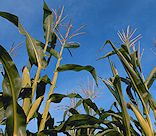
No one is saying that stalks will be as strong as Christmas tree trunks or that it will take seven or more years to grow a crop, but at least one plant breeder believes there might be a resemblance between the shape of Christmas trees and the shape of highly-productive corn plants in the future.
"The ideal shape would be that of a Christmas-tree type pattern, with leaves spreading out further below and more narrow at top," says Dave Nanda, president of Bird Hybrids, Tiffin, Ohio. Nanda occasionally writes articles for Indiana Prairie Farmer.
Some years ago, Nanda was the source for a story that talked about the potential for corn yields being 500 bushels per acre or more. No timeline was assigned to that prediction. One part of the theory that it was possible that plants of the future would be shaped differently than they are today.
"It's all about capturing as much sunlight as possible," Nanda says. "That's what drives photosynthesis and makes sugars for the plant. The plant then turns them into starches, protein and oils."
The beauty of the Christmas-tree shape is that narrower, upright leaves at the top of the plant would capture sunlight, then light remaining light filter down tot eh rest of the plant. Floppy, wider leaves at the base of the plant would capture remaining sunlight, Nanda observes. The idea is to capture as much sunlight as possible, with the least amount of sunlight hitting the ground as possible. If sunlight hits the ground, it's lost energy that the plant can't use in photosynthesis to make food for the plant, and eventually substances to fill corn kennels and boost yield, Nanda emphasizes.
This change won't come over night, he acknowledges. However, hybrids already vary in leaf type today. That means that genes for various types of genes are in the corn pool. Some hybrids today feature upright leaves. Others tend to have more floppy leaves. These are genetic characteristics. While they may not be selected for today, they could be in the future if breeders saw an advantage for doing so, he notes.
Its' just one of the changes that would be necessary to take corn yields to another level, Nanda believes. Population would also need to skyrocket, to perhaps 60 to 70,000 plants per acre. It's one reason he began testing inbred lines at 70,000 plants per acre to find promising new inbred material. Nanda began doing this a decade ago.
Some companies claim they will raise yields significantly by 2030 through adding traits. They might be well served to ask their breeders to consider focusing on some of the basic parts of the plant, and selecting for types that have an advantage.
About the Author(s)
You May Also Like




